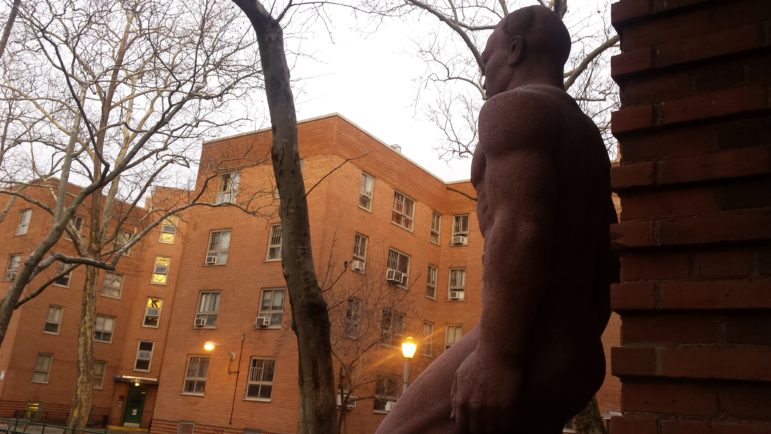
J. Murphy
A 1937 Heinz Warneke sculpture surveys the courtyard at Harlem River Houses.
If you want to alert NYCHA to an art installation on public-housing land or in a NYCHA building, email a site description (and if possible a photo) to art@nycha.nyc.gov.
* * * *
Facing deep infrastructure challenges and a hostile administration, NYCHA is tallying the artistic side of public housing’s essential contribution to the city’s fabric.
On the day when President Trump’s debilitating intentions toward public housing became clear, two figures stared at each other across a large courtyard in Harlem on Tuesday afternoon.
One had been beaten virtually beyond recognition, with part of her head missing, the stone skin of her body and of the child and dog at her side cracked and flaking. The other was nearly flawless, his features chiseled and his tools at hand, wearing an expression unchanged since it was sculpted in 1937—a time when the federal government believed that public housing and public art were essential to saving the nation.
Harlem River Houses was the second federally funded public housing development in the country to open to tenants, two years after the feds made their first such commitment at First Houses on the Lower East Side. The sculptures were funded by the New Deal’s Treasury Relief Art Project. Along with a third piece of bears wrestling that anchors a courtyard on the east side of the Harlem River development, they were created by Heinz Warneke, a leader of the direct carving movement in which the artist works straight on stone without models or mockups.
The three pieces are part of a larger contribution NYCHA has made to public art in the city, from murals at Queensbridge Houses to the camels that keep watch over the courtyard at Frederick Douglass Houses. It’s unclear just how many works there are in NYCHA’s 2,547 buildings or on the exterior of its 328 developments. That’s why the authority has undertaken a comprehensive effort to inventory the art it owns with the aim of making it more visible to residents and the city at large. In so doing, NYCHA’s leaders hope to make the value of public housing clearer to all.
In the years after Warneke’s works were installed in the courtyards along 152nd Street, the New York Housing Authority grew to be the nation’s largest and, by some measures, best administered public-housing agencies. While it certainly made mistakes and faced challenges throughout its history, NYCHA’s sheer size and the availability in the city of building managers who knew how to operate large apartment complexes helped the authority weather efforts to dismantle public housing that began almost as soon as the Roosevelt administration started building it. St. Louis detonated its Pruitt-Igoe complex in 1972. Under the HOPE VI program that launched in the early 1990s, tends of thousands of public-housing developments around the country were demolished, and not all of them replaced. New York City largely avoided those fates.
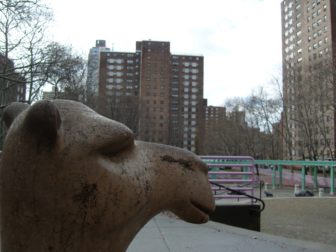
J. Murphy
A camel supervises the plaza at Frederick Douglass Houses in Manhattan.
However, NYCHA has been unable to elude the cuts in federal funding since the late 1990s (the city and the state at around the same time also abandoned public housing that they’d created, but both Albany and City Hall have since resumed some level of support). Insufficient operating support from Washington meant annual deficits and a lack of capital funds helped create a huge backlog of repair and replacement work, from leaky sinks and peeling paint to dead elevators and decayed roofs.
Under Chairwoman Shola Olatoye’s NextGeneration strategy, NYCHA has stabilized its budget, and new capital investment by Mayor de Blasio has allowed for some overdue maintenance work to commence.
But the authority’s long-term prospects hinge on plans to develop land for new, non-NYCHA housing—which has stirred controversy in some neighborhoods—and on support from the Trump administration. The Wall Street Journal reported on Tuesday that Trump’s Department of Housing and Urban Development, under Secretary Ben Carson, plans a cut of $35 million to NYCHA this year.
Given the fiscal threats that exist, it might seem a strange time to worry about NYCHA’s art collection. But Rasmia Kirmani-Frye—who as director of NYCHA’s Office of Public/Private Partnerships is overseeing the art survey—says the inventory is essential to the effort to change the negative perceptions that make NYCHA vulnerable to political assault.
“I think part of that is about a larger narrative about valuing public housing,” she tells City Limits. “New Yorkers understand the value of and feel connected to other systems with the word ‘public’ in front of it. Public transportation — people, like, get that. Public education. Public parks. Public art, in fact. But New Yorkers neither really understand the value nor feel connected to public housing in the same way.”
The project aims to catalogue all the public art on NYCHA territory. Right now it’s something staff are working on but eventually the authority plans to release a crowd-mapping tool for residents to contribute information on the art they see around them, and upload pictures. Some of the pieces might be highly visible, but other art might be hidden in plain sight because it’s fallen into disrepair. “Part of kind of being connected to this incredible city we’re all living in, which is such a hub of art in the world, is making sure that this art in public housing is seen as significant,” Kirmani-Frye adds. The goal, she says, is to “identify, restore and celebrate public-housing art.”
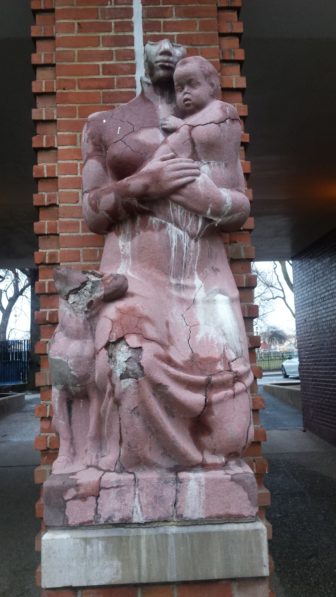
J. Murphy
The other Warneke sculpture in the main Harlem Rivers Houses courtyard is worse for wear.
While public art is most closely identified with the early NYCHA developments in Manhattan like First Houses and Harlem River Houses—both of which are city landmarks and on the National Register of Historic Places—Kirmani-Frye says early survey results indicate that public art is fairly widespread throughout the sprawling public-housing portfolio. Some of it is in the vein of the Warneke sculptures: officially sanctioned, formally funded, and of a style reflecting the authority’s New Deal origins. But more modern and more grassroots art like graffiti murals is also likely to be part of the inventory.
What Kirmani-Frye is less able to predict is whether NYCHA’s public art comprises an asset that can be used to help address the fiscal challenges. Describing the art inventory, a NYCHA spokeswoman said the authority was “looking into ways to leverage some of the great artworks at our developments into a public private partnership that can preserve public housing and the art it contains.”
At this stage, it’s not clear what such a partnership would look like. What is undeniable from NYCHA’s own history is that it art was always tied to a very practical purpose. “I think it was primarily about making work for artists,” says Nicholas Dagen Bloom, a professor at New York Institute of Technology who authored a history on NYCHA. “Although I do think the really hard core housing people were interested in creating a better environment. It was a way to include a wide range of people.”
The association of NYCHA with art might be more commonly held if all of the authority’s properties had the distinctive design and interesting layout of Harlem River Houses. But after the New Deal, the economics facing NYCHA changed drastically. “The cost of building even basic housing units in New York went up significantly after World War II,” says Bloom, “so just getting something built was a challenge.” This was true around the world, as minimalist designs took hold. For NYCHA that meant high-rises, standardized designs and cookie cutter landscapes—all of which clearly hampered NYCHA’s effort to maintain political support. “The design dimension of public housing, the looks, do not add positively to the feeling of the city about its value,” he says. “They are not grace notes in the landscape.”
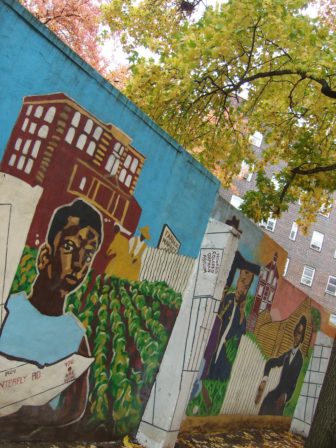
J. Murphy
A mural at the Kingsborough Houses.
This is the sentiment the art survey is hoping to combat—the idea that public housing is ugly, somehow separate from the rest of the city, from its daily life and its cultural richness. Kirmani-Fyre notes that the top three employers of NYCHA residents are the school system, the police department and NYCHA itself, and nine of the 10 top workplaces for the authority’s tenants are public agencies. In other words, the city is in some ways run by people who live in places like Harlem River Houses.
“A value-shifting narrative,” is what Kirmani-Frye is aiming for—one that she says will pose and answer a simple question: “Who is worthy of art? Everyone is worthy of art.”
Though the future of public housing in New York is uncertain, art remains part of the authority’s present. ArtBridge, an organization that establishes art in neglected urban spaces, recently worked at Langston Hughes Houses in Brownsville to create a large public art display featuring local artists.
And Monica Corbett, a resident leader at Pomonok Houses in Queens, says there are plans there to paint a mural there. “We want it to reflect growth. There isn’t any art in our development,” Corbett tells City Limits. “Our development is unique in where we sit in the fabric of NYCHA,” she adds, noting that “NYCHA residents are innovators” who are active in emerging art forms like web series.
Corbett isn’t sure what the mural would depict. “We are going to have a contest and see what community thinks,” she says.


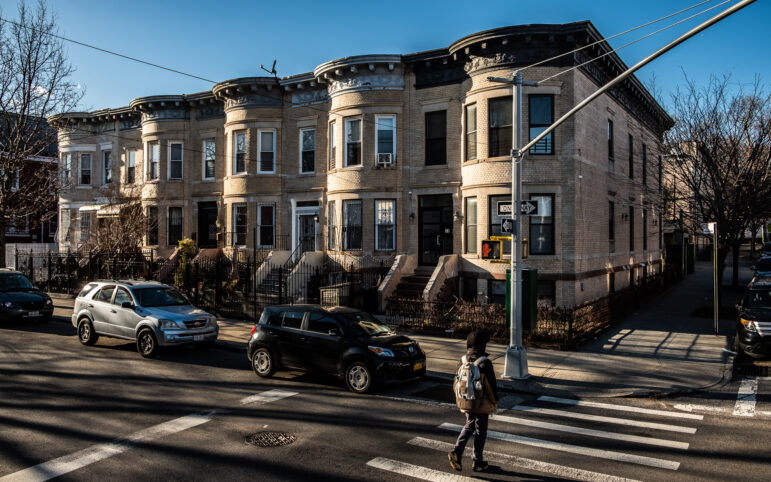
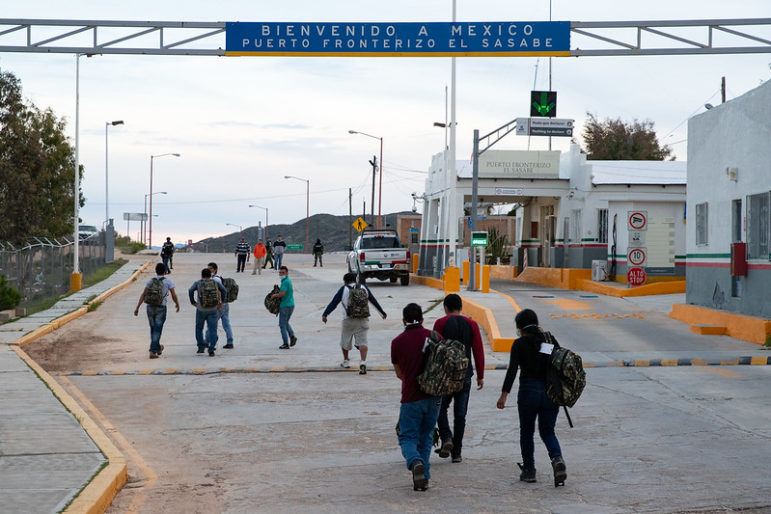





3 thoughts on “Ben Carson Might Slash its Budget, but Some see Public Housing as a Work of Art”
Very important read. We need more art in our lives.
The art within public housing in its exterior and some interior spaces too are a true treasure and legacy. Hopefully, each representation can be preserved, restored and saved. The art began at the very outset of public housing in the 1930’s To do this will require funding. Government funding is always a challenge to obtain but not impossible. Unfortunately, it’s not consistent.
In my opinion, NYCHA, City of New York should help form a non-profit in the same model of a conservancy like the Central Park or Battery Park Conservancy.
Private donors, foundations, organizations and individuals can be sources of revenue to get the non-profit going and sustained. Also major arts institutions should contribute in the spirit of being socially responsible. That could take the form of providing restoration, research and archival services in addition to or in lieu of funding.
Save the art in public housing.
Thank you,
Bill Russo
Retired NYCHA
Tel. 347-933-3337
Nyc ha has beautiful history but
It’s time for the residents to take
Back our development s build our
Capital find true solutions the
Mayor says he’s bldg 90 shelters
For the homeless u wanna be a
Part of that category this is
What it will be if we don’t start
Taking action and accountability
For our own development s
GOD BLESS AND PEACE A FED OF
TENANT.